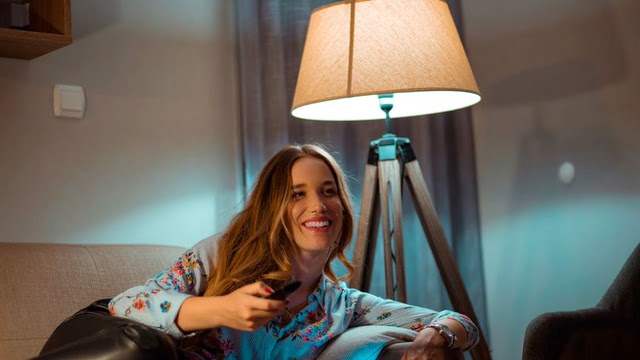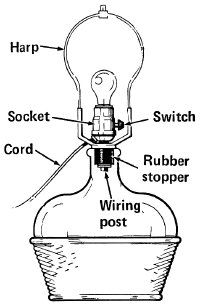Appliances

Lighting is an essential element for any home, and lamps are a great way to provide it. The versatility of lamps allows them to come in various shapes and sizes, making them a popular choice for both function and decor. In this article, we’ll explore how you can create your own customized lamp that perfectly suits your style and needs.
Did you know that you can use almost any household container to make a lamp? From wine bottles to baskets to mason jars, the possibilities are endless. If you want to add a seasonal touch, you can even fill a clear container with holiday candy or shells and marbles for a unique accent.
Changing the lamp shade is another easy way to give your lamp a new look. By selecting your own fabric and creating a slipcover, you can create a custom shade for an old lamp. Whether you’re looking to make major changes or minor tweaks, this article has you covered.
On the following page, we’ll walk you through the steps of transforming an ordinary container into an eye-catching lamp.
For more information on lighting and electricity, check out:
- How to Do Home Electrical Repairs: Whether you need to fix a broken light or a malfunctioning appliance, this site provides helpful tips for simple home electrical repairs.
- How Light Bulbs Work: Ever wondered what happens inside a light bulb? Learn about the inner workings of this essential lighting component.
- How Electricity Works: Gain a better understanding of the mysterious force that powers everything from toasters to Times Square.
Step-by-Step Guide to Making a Table Lamp

You don’t need to spend a lot of money to have a stylish lamp. With a hardware-store kit and lamp shade, you can turn any large container into a custom-designed table lamp. Follow these simple steps to create your own:
- Thread the wiring post through the stopper
- Plug the stopper in
- Add a harp and a light bulb
Necessary Tools:
- Pliers
- Screwdriver
- Drill (if needed)
Required Materials:
- Bottle, jar, or basket for the base
- Sand or weights
- Electric candlestick conversion kit (lamp kit) or socket and cord, plug, threaded hollow rod, and brass sheath
- Lamp harp
- Lamp shade
- Light bulb
- Silicone adhesive (if needed)
Time: 15 minutes to 1/2 hour
Choose any container you like for the base of the lamp, such as a large wine bottle, a basketed jug, a large jar, a pottery or ceramic jug, milk can, or a woven wicker basket. For the lamp base, ensure that the container is firmly weighted. If the container is opaque, fill it with sand or weight it with pieces of brick or lead. If the container is clear, use seashells, pebbles, buttons, matchbooks, layers of sand, dried beans, or any other item that appeals to you. The weight added to the container will keep the lamp base steady.
The type of container used determines the type of lamp kit or electric candlestick conversion kit that should be bought. For a solid container, the easiest wiring job would be to buy a kit that simply plugs into the top opening of the container, such as the standard type or the special kerosene-lamp type. With this kind of kit, the cord is attached at the top of the container, so no drilling is necessary. If a container that isn’t solid is used, such as a wicker basket, the lamp components should be bought separately. These components include a socket and cord, a plug, a threaded hollow rod, a brass sheath to cover it, and a lamp harp. With the long rod, the cord runs through the rod to the bottom of the base container; an opening will have to be drilled in the bottom for the cord.
Weight the lamp base before wiring it if a plug-in lamp kit is used. Then, follow the manufacturer’s instructions to assemble the wiring post. The kit includes several rubber stoppers of various sizes; find the stopper that best fits the top opening of the container. Thread the nipple of the wiring post or rod into the center of the stopper and tighten it securely. Screw the brass washer and locknut onto the base end of the rod; screw the lamp socket onto the other end. Insert the assembled wiring post into the weighted container, socket end up, and push the stopper firmly into place. This completes the wiring of the lamp.
To attach the lamp shade, add a lamp harp, which is a screw-on wire attachment. Attach the harp to the socket base as directed by the manufacturer. Then, remove the locknut at the top of the harp, set the lamp shade into place, and replace the locknut. Finally, screw a light bulb into the socket and plug the lamp in.
If you are using a wicker basket and a long threaded rod to wire a lamp, start by drilling a hole in the basket’s bottom for the rod and cord. If required, drill another hole in the basket’s cover for the top of the rod to pass through. The holes should be large enough to accommodate the rod itself on the bottom and the rod’s brass sheath on the top.
To assemble the components, thread the plug end of the cord through the rod and pull it through. Use the locking screws provided to secure the socket at the top of the rod. Slip the brass sheath over the rod to butt into the socket at the top.
Tie a loose knot in the cord near the base of the rod to reduce stress on the cord. Then, place the rod into the basket and pull the cord out through the opening in the bottom of the basket. To secure the rod at the lamp’s bottom, apply silicone adhesive to the bottom of the basket. Set the basket’s cover over the rod and secure the rod into the opening with silicone adhesive.
To complete the lamp, weight the base as described previously. Use a weighting material that won’t sift out of the basket. Clip the plug to the end of the cord, as directed by the manufacturer. Add a lamp harp, a shade, and a bulb to complete the lamp, as directed above.
With the lamp now shining brightly, continue to the next page to learn more about creating lamps. You can build one out of stovepipe!
For more information on lighting and electricity, see “How to Do Home Electrical Repairs,” “How Light Bulbs Work,” and “How Electricity Works.”
To make a sleek reading lamp, follow these easy instructions to build a stovepipe lamp. Assemble the pieces of pipe in a candy cane, with the bulb secured at the top, and weight the base solidly.
Tools required include a measuring rule, pencil, handsaw or saber saw, fine-toothed flat file, power drill, caulking gun, scissors, screwdriver, wire cutters, and wire stripper. Materials required include 6-inch straight and elbow stovepipe sections, scrap 3/4-inch plywood, construction adhesive, bricks or lead weights, heavy felt, white glue, porcelain lamp socket with screws, newspaper, masking tape, matte black or matte white spray paint for metal, lightweight lamp cord, lamp turn switch, quick-clamp plug, spray metal primer, high-gloss spray enamel, and a 40-, 75-, or 100-watt light bulb. The project should take about 2 to 4 hours.
If you want to create a stovepipe lamp, you can fit together pieces of pipe in any desired shape. This particular lamp, shaped like a candy cane, is 6 inches wide and 54 inches tall, and is ideal for reading or bedside use. You can paint it any color you like, but shiny red is recommended. To make a 54-inch candy cane lamp, you will need two 24-inch straight pipe sections, two 90-degree elbow sections, and 12 feet of lightweight lamp cord.
To create the lamp base and bulb base, cut two circular pieces of scrap 3/4-inch plywood with the exact same diameter as the stovepipe. Measure the uncrimped end of one straight section and the crimped end of one elbow section precisely to make sure they fit. Draw around them on a piece of plywood and adjust to the measured diameter.
Carefully cut out the two discs with a handsaw or a saber saw, following the traced lines. The discs should fit snugly inside the stovepipe sections, and the edges of the discs should be smoothed with a fine-toothed flat file.
To make the lamp base, drill a hole with an electric drill about 12 inches up from the uncrimped end of the straight bottom pipe to accommodate the lamp switch. Drill another hole on the other side of the pipe section about 1 1/4 inches up from the uncrimped bottom of the pipe to fit the lamp cord. Apply a bead of construction adhesive all around the cut edge of the plywood base disc with a caulking gun. Carefully set the disc into the uncrimped end of the pipe and adjust it from both ends of the pipe to make sure it is level, flush with the bottom pipe edge, and firmly wedged into the pipe. Trace the section of stovepipe onto a piece of heavy felt, cut out a circle of felt, and attach it to the outside face of the disc with white glue to finish the outside of the lamp base. Let the glue and construction adhesive dry completely.
Once the base is dry, weigh it down with 5 pounds of bricks or lead weights to keep the lamp stable. Attach the weights to the plywood base inside the pipe with construction adhesive, making sure not to block the switch hole or the cord hole.
Cut a narrow slice off one side of the other plywood disc to make room for the wires to enter the body of the lamp. Screw a porcelain lamp socket to the center of the disc and attach the wires of the lamp cord. Apply a bead of construction adhesive to the cut edge of the disc, except for the sliced-off edge, and set the disc into the crimped end of one elbow section of pipe with the socket side facing out. Make sure the disc is firmly anchored and set straight into the end of the pipe. The bulb will project straight out from the socket into the second elbow section.
After allowing the construction adhesive to dry according to the manufacturer’s instructions, paint the inside of the lamp’s bulb end. Matte black spray paint can be used for a focused bedside light, while matte white is suitable for more diffused lighting. The second elbow section should be positioned over the crimped end of the first one, with the socket assembly in the middle of the two curved pipe pieces and the bulb socket facing outward. Adjust the pipe pieces to the desired angle and push them together firmly. Protect the workspace with newspaper and cover the socket opening in the elbow assembly with masking tape before spraying the inside of the curved section with matte black or matte white paint. Wait for the paint to dry completely before removing the masking tape from the socket. Drill three 3/8-inch holes across the top of the stovepipe above the light bulb location to dissipate heat. Thread the end of a 12-foot lightweight lamp cord through the cord hole in the bottom straight section and tie a loose knot in the cord after leaving about 8 to 9 feet outside the pipe. Bring the wire up the base piece of the stovepipe and across to the drilled switch hole. Carefully separate the two insulated wires of the cord for a few inches and cut one of them. Use a wire stripper to remove about 1/2 inch of insulation from the two cut ends and connect them to the two screw terminals on the lamp switch. Insert the switch into the hole in the stovepipe and secure it with a lock ring. Set the other straight piece of pipe onto the base piece, uncrimped end down, and push it firmly to join the two pieces securely. Finally, attach a quick-clamp plug to the free end of the lamp cord to complete the lamp assembly.
To finish the lamp, use a spray metal primer and high-gloss spray enamel. Before painting, cover your workspace with newspaper and the lamp cord and switch with masking tape and newspaper. Cover the bulb opening and vent holes with masking tape. Apply a light coat of primer and let it dry before applying two or three coats of spray enamel. Follow the manufacturer’s instructions and let the paint dry completely. Remove all tape and paper, then screw in a 40-, 75-, or 100-watt light bulb. If you want to revamp an old lamp, check the next page for instructions on covering a lamp shade. For more information on lighting and electricity, check out the resources provided. The shirred lamp shade slipcover allows you to customize the look of your lampshade using any lightweight fabric.
Essential tools:
- a measuring tape
- a pair of sharp scissors
- straight pins
- a sewing machine
- a steam iron and ironing board
- a safety pin or a bodkin
Required materials:
- a plain lamp shade (without any ruffles or pleats)
- lightweight fabric
- thread
- medium-weight round elastic cord
Time: 30 minutes to 1 hour
If you want to cover a lamp shade, choose lightweight fabric that will fall into soft folds. Buy one yard of 44- or 45-inch fabric for a general lamp shade. However, if the shade is more than 15 inches tall, buy an extra 2 inches of fabric for each additional inch of height. Additionally, purchase three yards of medium-weight round elastic. If the lamp shade has any fringe or trim, remove it carefully without damaging the shade.
Begin by measuring the height of the shade and add three inches. Then, cut two strips of fabric to that measurement across the width of the fabric. For example, if the shade is 12 inches high, cut two 15-inch strips across the width of the fabric. Place the fabric strips with the right sides together at the selvage, pin the selvage ends together, and sew the pinned ends together on a sewing machine. Leave a 1/2-inch seam allowance. Remove the pins and open the seamed pieces to form a long strip of fabric.
Measure around the bottom of the lamp shade and multiply this circumference by 1 1/2 to determine the length needed for the strip of fabric. For instance, if the shade measures 50 inches around the bottom, you’ll need a strip of fabric approximately 75 inches long to cover it. This is the minimum fullness, and if your fabric is soft or thin, you may need to use more. Measure and trim the long strip to the required length, cutting from both ends of the fabric to keep the seam centered.
Once the strip is trimmed to the proper size, fold it in half at the seam, with the right sides together, and stitch the two loose ends together with a 1/2-inch seam. Turn under 1/2 inch of fabric along each long, raw edge of the piece and press it down. Then, turn each folded edge under again 1/2 inch and press. Pin the hems in place and stitch them all the way around, leaving a 1-inch opening in each long hem. Backstitch at the beginning and end of each hem.
Cut a piece of round elastic to the same length as the bottom circumference of the shade. Tie one end of it to a bodkin or a large safety pin and insert it into one of the hems through the 1-inch opening in the hem. Pull the elastic by the bodkin or pin all the way around inside the hem and out again, gathering the fabric onto the elastic as you go. Tie the two ends of the elastic in a square knot and let it slip inside the hem. Then cut another piece of elastic the circumference of the top of the shade; insert it into the other hem of the fabric and tie the ends together the same way.
To use your new lamp shade cover, remove the lamp shade from the lamp. Slip the cover over the lamp shade and adjust the gathered fabric evenly all the way around. If the cover isn’t snug enough, retie the elastic to make it tighter.
To learn more about electricity and lighting, check out:
- Home Electrical Repair: Discover how to fix simple electrical problems like malfunctioning switches, dead appliances, or dark rooms.
- Light Bulb Technology: Uncover the inner workings of light bulbs and how they provide illumination to your home or office.
- Electricity Fundamentals: Understand the basics of electricity and how it powers everything from small appliances to large cities like New York.
FAQ
1. What materials do I need to build a lamp?
To build a lamp, you will need some basic materials, such as a lamp kit, a lampshade, a light bulb, a lamp base, and some tools, including a screwdriver, a wire stripper, and pliers. You can also use some other materials to decorate your lamp, such as paint, glue, or fabric.
2. Can I build a lamp without a lamp kit?
You can build a lamp without a lamp kit, but it may be more difficult and time-consuming. You will need to find all the necessary parts, such as a socket, a cord, a plug, and a switch, and assemble them yourself. It is also important to ensure that all the electrical connections are safe and secure.
3. How do I choose a lampshade?
When choosing a lampshade, consider the style and size of your lamp base, as well as the color and pattern of your room. A larger lamp base will require a larger shade, while a smaller base will need a smaller shade. You can also choose a shade that complements or contrasts with the color scheme of your room.
4. Can I use any type of light bulb for my lamp?
No, you cannot use any type of light bulb for your lamp. Make sure to choose a bulb that is compatible with your lamp kit and socket, and that has the appropriate wattage for your needs. You can also choose bulbs with different colors or intensities to create the desired ambiance.
5. How do I assemble the lamp kit?
To assemble the lamp kit, follow the instructions that came with it. Generally, you will need to attach the socket and cord to the base, connect the wires, and tighten the screws. It is important to make sure that all the connections are secure and that no wires are exposed.
6. How do I decorate my lamp?
You can decorate your lamp in various ways, depending on your style and preferences. You can paint the lamp base or shade, add stickers or decals, wrap fabric or ribbon around the base, or glue beads or other embellishments. Just make sure to use materials that are safe and heat-resistant.
7. Can I build a lamp from scratch?
Yes, you can build a lamp from scratch, but it requires more advanced skills and knowledge of electrical wiring. You will need to find the necessary parts, such as a transformer, a diode, a capacitor, and a resistor, and assemble them according to a circuit diagram. It is also important to follow safety guidelines and regulations.
8. How do I install the lamp?
To install the lamp, plug it into a wall outlet or a power strip, and turn on the switch. Make sure that the lamp is stable and does not tip over easily. It is also important to place the lamp away from flammable materials and to avoid touching the bulb when it is hot.
9. How do I maintain my lamp?
To maintain your lamp, clean it regularly with a soft cloth or a duster. Avoid using abrasive or chemical cleaners that can damage the surface or the electrical components. Replace the bulb when it burns out or when it is too dim. Check the wiring and connections periodically to ensure that they are safe and secure.

Brody is a skilled craftsman and gardening expert. From renovating living spaces to cultivating lush gardens, Brody’s knowledge and passion shine through, inspiring readers to embark on their own home improvement and gardening journeys with confidence.






Leave a Reply